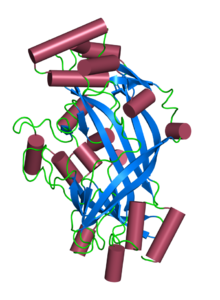↑ Tandon NN, Kralisz U, Jamieson GA (May 1989). "Identification of glycoprotein IV (CD36) as a primary receptor for platelet-collagen adhesion" . The Journal of Biological Chemistry . 264 (13): 7576–83. PMID 2468670 . [پیوند مرده ↑ Silverstein RL, Baird M, Lo SK, Yesner LM (August 1992). "Sense and antisense cDNA transfection of CD36 (glycoprotein IV) in melanoma cells. Role of CD36 as a thrombospondin receptor" . The Journal of Biological Chemistry . 267 (23): 16607–12. PMID 1379600 . [پیوند مرده ↑ Oquendo P, Hundt E, Lawler J, Seed B (July 1989). "CD36 directly mediates cytoadherence of Plasmodium falciparum parasitized erythrocytes". Cell . 58 (1): 95–101. doi :10.1016/0092-8674(89)90406-6 . PMID 2473841 . ↑ Endemann G, Stanton LW, Madden KS, Bryant CM, White RT, Protter AA (June 1993). "CD36 is a receptor for oxidized low density lipoprotein" . The Journal of Biological Chemistry . 268 (16): 11811–6. PMID 7685021 . [پیوند مرده ↑ Nicholson AC, Frieda S, Pearce A, Silverstein RL (February 1995). "Oxidized LDL binds to CD36 on human monocyte-derived macrophages and transfected cell lines. Evidence implicating the lipid moiety of the lipoprotein as the binding site" . Arteriosclerosis, Thrombosis, and Vascular Biology . 15 (2): 269–75. doi :10.1161/01.ATV.15.2.269 . PMID 7538425 . Archived from the original on 23 February 2013. Retrieved 8 December 2017 . ↑ Calvo D, Gómez-Coronado D, Suárez Y, Lasunción MA, Vega MA (April 1998). "Human CD36 is a high affinity receptor for the native lipoproteins HDL, LDL, and VLDL" . Journal of Lipid Research . 39 (4): 777–88. PMID 9555943 . [پیوند مرده ↑ Podrez EA, Poliakov E, Shen Z, Zhang R, Deng Y, Sun M, Finton PJ, Shan L, Gugiu B, Fox PL, Hoff HF, Salomon RG, Hazen SL (October 2002). "Identification of a novel family of oxidized phospholipids that serve as ligands for the macrophage scavenger receptor CD36". The Journal of Biological Chemistry . 277 (41): 38503–16. doi :10.1074/jbc.M203318200 . PMID 12105195 . ↑ Baillie AG, Coburn CT, Abumrad NA (September 1996). "Reversible binding of long-chain fatty acids to purified FAT, the adipose CD36 homolog" . The Journal of Membrane Biology . 153 (1): 75–81. doi :10.1007/s002329900111 . PMID 8694909 . ↑ Hajri T, Han XX, Bonen A, Abumrad NA (May 2002). "Defective fatty acid uptake modulates insulin responsiveness and metabolic responses to diet in CD36-null mice" . The Journal of Clinical Investigation . 109 (10): 1381–9. doi :10.1172/JCI14596 . PMC 150975 PMID 12021254 . ↑ Pravenec M, Landa V, Zídek V, Musilová A, Kazdová L, Qi N, Wang J, St Lezin E, Kurtz TW (2003). "Transgenic expression of CD36 in the spontaneously hypertensive rat is associated with amelioration of metabolic disturbances but has no effect on hypertension" (PDF) . Physiological Research . 52 (6): 681–8. PMID 14640889 . ↑ Febbraio M, Podrez EA, Smith JD, Hajjar DP, Hazen SL, Hoff HF, Sharma K, Silverstein RL (April 2000). "Targeted disruption of the class B scavenger receptor CD36 protects against atherosclerotic lesion development in mice" . The Journal of Clinical Investigation . 105 (8): 1049–56. doi :10.1172/JCI9259 . PMC 300837 PMID 10772649 . ↑ Laugerette F, Passilly-Degrace P, Patris B, Niot I, Febbraio M, Montmayeur JP, Besnard P (November 2005). "CD36 involvement in orosensory detection of dietary lipids, spontaneous fat preference, and digestive secretions" . The Journal of Clinical Investigation . 115 (11): 3177–84. doi :10.1172/JCI25299 . PMC 1265871 PMID 16276419 . ↑ Pepino MY, Love-Gregory L, Klein S, Abumrad NA (March 2012). "The fatty acid translocase gene CD36 and lingual lipase influence oral sensitivity to fat in obese subjects" . Journal of Lipid Research . 53 (3): 561–6. doi :10.1194/jlr.M021873 . PMC 3276480 PMID 22210925 . ↑ DiPatrizio NV (September 2014). "Is fat taste ready for primetime?" . Physiology & Behavior . 136 : 145–54. doi :10.1016/j.physbeh.2014.03.002 . PMC 4162865 PMID 24631296 . ↑ Drover VA, Ajmal M, Nassir F, Davidson NO, Nauli AM, Sahoo D, Tso P, Abumrad NA (May 2005). "CD36 deficiency impairs intestinal lipid secretion and clearance of chylomicrons from the blood" . The Journal of Clinical Investigation . 115 (5): 1290–7. doi :10.1172/JCI21514 . PMC 1074677 PMID 15841205 . ↑ Rać ME, Safranow K, Poncyljusz W (2007). "Molecular basis of human CD36 gene mutations" . Molecular Medicine . 13 (5–6): 288–96. doi :10.2119/2006-00088.Rac . PMC 1936231 PMID 17673938 .
